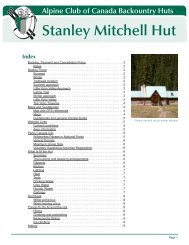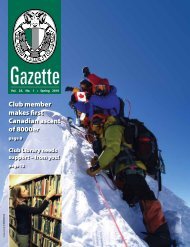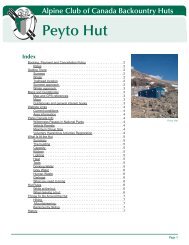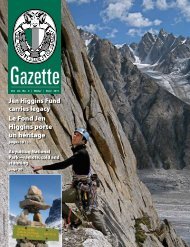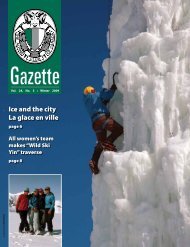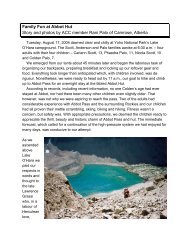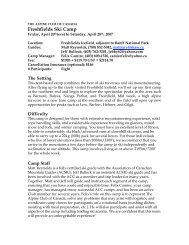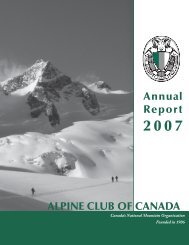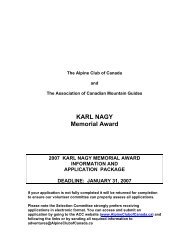Winter 2010 - The Alpine Club of Canada
Winter 2010 - The Alpine Club of Canada
Winter 2010 - The Alpine Club of Canada
- No tags were found...
Create successful ePaper yourself
Turn your PDF publications into a flip-book with our unique Google optimized e-Paper software.
<strong>The</strong>re’s shi* in them thar hills<br />
by Lynn Martel<br />
A<br />
life goal <strong>of</strong> his, says University<br />
<strong>of</strong> British Columbia PhD<br />
candidate Ge<strong>of</strong>f Hill, is turning<br />
waste streams into valuable commodities.<br />
Toward that end, Hill’s PhD project<br />
focuses on designing improved systems<br />
for managing human waste in alpine and<br />
arctic regions.<br />
“It’s my life’s work to try to integrate<br />
humans into the ecosystems that support<br />
us,” Hill stated. “If you look at any<br />
ecosystem, its health and richness can<br />
be characterized by its degree <strong>of</strong> waste<br />
integration.”<br />
Currently, flying 200-litre drums filled<br />
with human waste, 80 or 90 per cent <strong>of</strong><br />
which is urine, by helicopter long-line<br />
is the most common method <strong>of</strong> waste<br />
removal from backcountry sites throughout<br />
Alberta and BC’s mountains.<br />
But, Hill points out, unsustainable<br />
methods are not restricted to backcountry<br />
cabins.<br />
“We’re very accustomed to flushing<br />
a .2-kilogram poop or a .3-litre piss with<br />
20 litres <strong>of</strong> potable water,” Hill explained.<br />
“Somehow we’ve tricked ourselves into<br />
thinking this isn’t crazy. But it’s clearly<br />
outrageous to long-line drums <strong>of</strong> excrement<br />
by helicopter from provincial and<br />
national parks all across North America.<br />
<strong>The</strong> helicopter is one <strong>of</strong> the most inefficient<br />
vehicles ever made, and one <strong>of</strong> the<br />
most dangerous and most expensive<br />
vehicles to operate.”<br />
So, Hill is studying the benefits, costs<br />
and performance capabilities <strong>of</strong> potential<br />
alternate methods. An avid climber, last<br />
summer Hill conducted research in BC’s<br />
Bugaboo Provincial Park.<br />
“With the line <strong>of</strong> work I’m in, the<br />
least I can do for myself is choose a<br />
beautiful place,” Hill said. “Bugaboo<br />
Park is very popular and it has numerous<br />
backcountry toilets, including forest-level<br />
pit toilets, Kain Hut barrels, Applebee<br />
Camp barrels and high alpine thrones at<br />
the Bugaboo Snowpatch Col and Pigeon<br />
Howser Col.”<br />
At this point in his research, the most<br />
promising alternatives are urine diversion—preventing<br />
urine, which is sterile,<br />
from coming into contact with feces,<br />
which are pathogen rich—combined with<br />
dehydration. He is also collecting data on<br />
composting toilets in Kananaskis Country,<br />
Little Yoho Campground<br />
and in the US.<br />
In the Bugaboos, a<br />
urine diversion seat, combined<br />
with dehydration,<br />
has yielded an 84 to 95 per<br />
cent mass reduction <strong>of</strong> the<br />
total waste. Hill is also<br />
testing a hydro-powered<br />
ash incinerator, using the<br />
mini-hydro system which<br />
provides clean electricity<br />
to the <strong>Alpine</strong> <strong>Club</strong> <strong>of</strong><br />
<strong>Canada</strong>’s (ACC) Conrad<br />
Kain Hut.<br />
One key element <strong>of</strong><br />
his research is to develop<br />
a system that can be retr<strong>of</strong>it into existing<br />
toilets, keeping costs low. Fortunately,<br />
urine diversion seats and urinals retr<strong>of</strong>it<br />
easily into most backcountry toilets. Once<br />
his data is complete, it will be available to<br />
park operators and policy makers.<br />
Hill’s research is <strong>of</strong> particular value to<br />
the ACC, which operates 27 backcountry<br />
huts, ranging from 30-person log cabins<br />
in sub-alpine locations to four-person<br />
shelters perched high in the alpine.<br />
Most <strong>of</strong> these huts rely on fly-out barrel<br />
systems, piggy-backing helicopter flights<br />
to deliver empty barrels and propane pigs<br />
for lights and cooking while removing<br />
full barrels.<br />
In July, Karen Rollins, project director<br />
for BEES, the ACC’s Backcountry<br />
Energy and Environmental Solutions<br />
committee, and three other ACC representatives<br />
attended the Exit Strategies—<br />
Managing Human Waste in the Wild<br />
conference in Golden, Colorado.<br />
Attendees included land managers, scientists,<br />
entrepreneurs and wilderness operators<br />
from as far as Alaska, New Zealand,<br />
Japan, Nepal and Argentina.<br />
“One <strong>of</strong> the main points that came<br />
out <strong>of</strong> the conference was that for every<br />
region, although we all experience difficulties<br />
in waste management, the solution<br />
is always going to be a bit different,”<br />
Rollins said. “BEES is trying to get away<br />
from fossil fuels. For the ACC, there’s<br />
still room for research, and that’s why<br />
BEES exists.”<br />
In western <strong>Canada</strong>, where temperatures<br />
regularly dip below freezing in<br />
the alpine nine or 10 months <strong>of</strong> the year,<br />
This "green throne", perched at the frequently visited Pigeon/Howser<br />
Col, is one <strong>of</strong> several backcountry toilets in BC's Bugaboo Provincial Park.<br />
photo by Lynn Martel.<br />
a barrel <strong>of</strong> waste created in January or<br />
February will still have a chunk <strong>of</strong> ice in<br />
it in July. While some southern US parks<br />
are successfully employing composting<br />
toilets, they rely on warmth to work<br />
properly.<br />
“In the alpine, it’s very—extremely—<br />
challenging, because <strong>of</strong> the temperature<br />
requirements,” Rollins said. Pit toilets,<br />
she added, require soil and bedrock for<br />
micro-organisms to break down the<br />
waste—elements not readily available, or<br />
penetrable, in the alpine.<br />
“<strong>The</strong> key for all <strong>of</strong>f-grid waste management<br />
solutions is urine separation,”<br />
Rollins said.<br />
In northern Europe, she added, urine<br />
separation is already being carried out,<br />
with the urine being used as fertilizer.<br />
“Urine diversion is cheap, easy and<br />
reliable,” Hill said. “But the impacts<br />
<strong>of</strong> urine diversion on alpine and arctic<br />
soils and plant communities are little<br />
known. If diverted correctly, my hypothesis<br />
is that local plant communities will<br />
thrive. <strong>The</strong>re is clear evidence showing<br />
that urine can be used as fertilizer on a<br />
wide range <strong>of</strong> crops with high productivity,<br />
including tomatoes, cucumbers and<br />
bananas.”<br />
Employing expertise gained from his<br />
Masters thesis that examined climate<br />
change impacts on arctic sedge meadow<br />
communities, Hill has initiated a project<br />
that utilizes urine from a remote arctic<br />
field camp in the production <strong>of</strong> leafy<br />
greens in a semi-permanent greenhouse.<br />
He also hopes to use waste cooking oil as<br />
fuel for the camp’s diesel power generator.<br />
12 <strong>Alpine</strong> <strong>Club</strong> <strong>of</strong> <strong>Canada</strong> Gazette <strong>Winter</strong> <strong>2010</strong>



